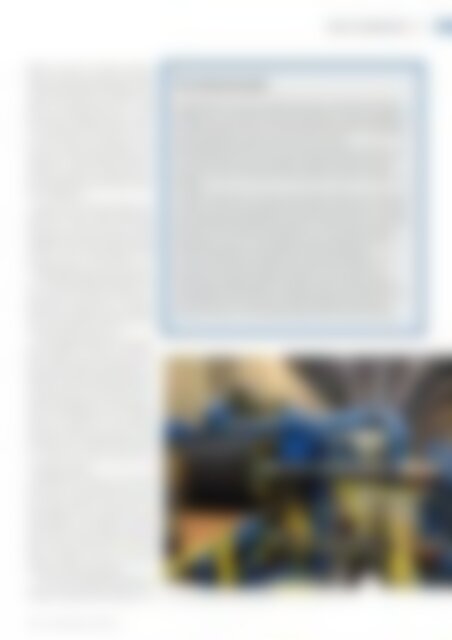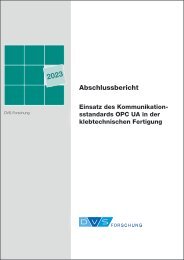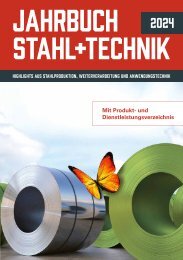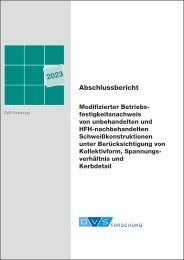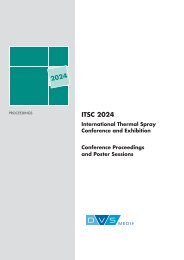STEEL + TECHNOLOGY 01/2020 EXTRACT
STEEL + TECHNOLOGY 01/2020 EXTRACT
STEEL + TECHNOLOGY 01/2020 EXTRACT
You also want an ePaper? Increase the reach of your titles
YUMPU automatically turns print PDFs into web optimized ePapers that Google loves.
<strong>STEEL</strong> <strong>TECHNOLOGY</strong> | 49<br />
Bridles from BTU. The latter would be<br />
used to produce the high strip tension<br />
required for advanced steel grades. Thanks<br />
to their specific design, Umlauf Bridles can<br />
apply much higher forces onto the strip<br />
than e.g. conventional bridle rolls – while<br />
requiring less installation space. What is<br />
more, they apply the strip tension uniformly<br />
over the entire strip width and rule out<br />
the risk of lengthwise scratching of the<br />
strip surface. Umlauf Bridles have been in<br />
operation in several European plants for<br />
more than 25 years, with operators reporting<br />
very good performance and low equipment<br />
maintenance.<br />
Due to the convincing concept of an<br />
integrated solution and the good experience<br />
with Umlauf Bridle technology<br />
reported by other steel companies, SDI’s<br />
management chose the solution proposed<br />
by SES: a 140 ton SuperLeveler provided<br />
by SES and two Umlauf Bridles – one<br />
arranged ahead and one after the leveler.<br />
The scope of supply additionally included<br />
a third Umlauf Bridle arranged in the<br />
run-out section of the pickle line. This configuration<br />
has made the line in Columbus<br />
the world’s first pickle line to use exclusively<br />
Umlauf Bridle technology to move<br />
the strip through a pickle line.<br />
SDI placed the order for the project with<br />
SES as general contractor in February<br />
2<strong>01</strong>8. Project work on site started on 25<br />
January 2<strong>01</strong>9: SES disassembled the complete<br />
entry section equipment between<br />
the pay-off reel and the pickling tank entry,<br />
as well as the pinch roll unit at the line exit.<br />
They then installed and commissioned the<br />
three Umlauf Bridles and the levelling<br />
machine complete with the associated<br />
electrical and automation systems. After<br />
successful hot commissioning, the pickle<br />
line went back on stream on 10 February<br />
– i.e. only 17 days from the start of the<br />
disassembling work.<br />
Ahead of the leveler, the first Umlauf<br />
Bridle performs as a braking unit and the<br />
second one, arranged behind the leveler,<br />
as a pulling device. In this set-up, the<br />
Umlauf Bridles – each requiring an installation<br />
length of only 2,200 mm – generate<br />
strip tensions of up to 1,250 kN to level the<br />
strip. The first Umlauf Bridle in the line<br />
bites the head of the up to 13 mm thick<br />
and up to 1,880 mm wide strip, guiding it<br />
directly into the tension leveler.<br />
The third Umlauf Bridle arranged at the<br />
run-out of the pickling section bites the<br />
head of the pickled strip and guides it into<br />
The Umlauf principle<br />
Umlauf Bridles consist of two crawler-type chain units featuring an elastic<br />
padding. One unit is arranged above and one below the strip. They guide and<br />
transport the strip linearly, i.e. without any deflection, at different stages of<br />
strip processing lines. Thanks to their extreme compactness, Umlauf Bridles<br />
can be arranged at basically any position within the line.<br />
By applying the force over an area – and not concentrated in one point – any<br />
local concentrations of forces or relative movements between the crawler<br />
unit and the strip surface are prevented. Therefore, the risk of surface<br />
damage is ruled out, making this technology highly suitable for delicate strip<br />
surfaces.<br />
A single Umlauf Bridle unit may be used to apply large forces to the strip, for<br />
example, in order to pull it through side trimmers or slitting lines. This aspect<br />
is of particular interest especially when processing thick strip. The unit may<br />
also be installed to decouple the strip tension of a line section from upstream<br />
processes or even reduce the strip tension to “zero”. By reducing strip<br />
back-tension to “zero”, an Umlauf Bridle makes it possible, for example, to<br />
measure the flatness of the strip without any interfering effects.<br />
As the Umlauf Bridles are arranged within the strip processing line, they<br />
build up the strip tension before the coiler bites the strip head. This<br />
significantly increases the usable coil length, in other words the yield. In<br />
certain strip processing lines this may lead to a plus of 20 meters per coil.<br />
Umlauf Bridles can be rotated very precisely through their vertical axis. This<br />
feature allows them to reduce strip camber during stretch leveling and<br />
correct the strip run so as to achieve highly precise trimming or recoiling.<br />
Entry section of the BTU Umlauf Bridle (Picture: SES Engineering)<br />
<strong>STEEL</strong> + <strong>TECHNOLOGY</strong> 2 (<strong>2020</strong>) No. 1


